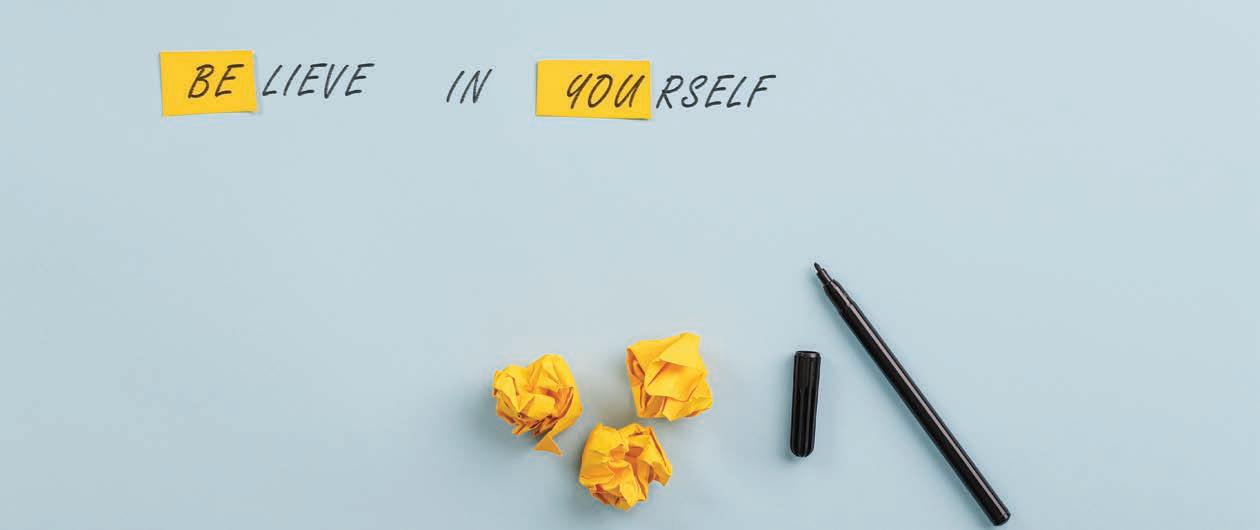
3 minute read
The Foundation of Self-Trust
By Sydni Marmor, LPC
The concept of self-trust is the topic foremost on the minds of those who sit on my couch. Self-trust, in my opinion, is the foundation for starting any therapeutic journey because when we start therapy, we trust ourselves enough to know that we need change. As we explore our developed identity in therapy, we are invited to contemplate what flavor of self-trust we currently experience: is this flavor rooted in authentic expression, or is it rooted in conditioned beliefs and behaviors?
Advertisement
Our minds and personalities are shaped by our life experiences and therefore influence our day-to-day interactions and choices. Our jobs, partners, friends, hobbies, and communities are all influenced by how our experiences in and of the world have shaped us into being. Learning our own unique flavor of selftrust, therefore, can become a paradigm shift in our lives. When we take a deeper dive into the narratives that we have built about ourselves and how we live our lives, we start to question whether our instincts are truly in alignment with our authentic selves. As we ponder the difference between conditioned truth and authentic truth, we are invited into an opportunity to experience ourselves through this new lens.
What Is Your Truth?
Discovering our authentic truth and developing self-trust is a process of working through our beliefs, actions, conditions, and behaviors by asking ourselves, “Why do I think this? Is this in alignment with who I am? Where did this belief come from? What is the story behind this?” When we take the time to explore our-
selves from this perspective, we slowly reintroduce ourselves to our authentic identity. We learn what was conditioned from family or culture, friends or community, and partners or workplace. We develop the skills needed to discern what is authentically ours and what was conditioned. This is an opportunity to explore whether we want to keep our current perceptions or beliefs, or if we are ready to leave them behind as they no longer align with who we are or who we want to become. This process, although very slow, becomes the foundation for learning how to authentically trust ourselves.
The joy of this process is that once we’ve built enough self-trust that we can be compassionately curious about who we are, we can then begin the journey of making mistakes. This is one of the messiest, yet most fun, parts of the therapeutic journey, as it requires a beginner’s mind, self-compassion, and a ton of bravery. As we begin to embody our most authentic self, we must go out into the world and experience it from this new lens and new perspective. This could mean trying new foods or activities, experiencing a new culture, setting boundaries, changing jobs, or ending relationships—the sky is the limit. But this part of the process requires us to put ourselves out there and try our new identity on. It is where we fine tune the parts of us coming into alignment and bring balance to who we truly are.
Trying on Your Authentic Self
In our journey of discovering our authentic self, we sometimes dance in the polarities of who we used to be and who we authentically are. The ultimate goal, therefore, is to try life on and see where we truly fall in our pendulum of self-identity. This experimentation allows life to be a playground for self-exploration so we can truly discover how we want to show up in the world. It requires us to give ourselves permission to make mistakes and continue to learn who we authentically are. Yes, there will be many mistakes and messes to clean up throughout this process, but trusting ourselves is an embodied experience—and the best way to embody self-trust is to go out into the world, taste all the flavors it has to offer, and see which pairings suit us best. Sydni Marmor, LPC, is a licensed professional counselor, Reiki master, and registered yoga teacher. She is passionate about working with female empowerment, self-identity exploration, creative expression, and mindfulness education. Outside of therapy, you can find her backpacking or journaling. You can learn more about her work at gatherandbecome.com.










